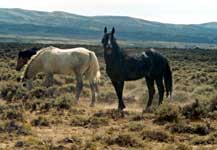

WILD HORSES
SOUTHWEST WYOMING HERDS
Information
Wild
horses have always been symbols of the West, living examples of a wide-open
landscape and an untamed frontier spirit.
Horses were first seen in this country about 10,000 years ago, but for unknown
reasons became extinct. They were not seen again for another 9,000 years when
the Spanish reintroduced them in the 1500ís.
Current herds are descendents of those Spanish horses along with animals turned
out by ranchers or enticed away from ranches by wild horse herds. In addition to
the wild horses, visitors have a chance to see an abundance of wildlife and take
in some of the best scenic vistas in Wyoming.
This is a relatively dry area with seemingly little vegetation. However, it is
home to a surprising array of wild creatures. These include wild horses,
antelope, desert elk, deer, rabbits, coyotes, hawks, eagles and sage grouse,
among others. The rock formations, the color of the rocks, the grand mountain
vistas, offer exciting views. High desert mountain areas where out tours occur,
varies from very interesting to extraordinary. The Rocky Mountains' reputation
for magnificence has earned it the hard way, gawk by gawk. Big deep blue western
skies and broad western rim buttes that stretch for miles and miles.
Most wild horses in Wyoming are located in the southwestern quarter of the
state. The Rock Springs BLM is the headquarters of the Wild Horse Program in
Wyoming. The appropriate management level for wild horses in Wyoming is
approximately 6,000. 2,500 of these horses are in the Rock Springs District.
There are also herds located near Adobe Town, which is managed by the Rawlins
BLM office.
The existence of the herds of wild horses is a credit to the private landowners
of this area who do not fence their land, thus allowing the horses to wander as
necessary for food, water, and shelter in the winter as nature provides.
The Bureau of Land Management (BLM) conducts a periodic census of the wild horses to determine how many animals must be removed from the range. As a result there are fewer cases of injury or death from starvation, dehydration, and susceptibility to the elements. The horses are gathered at various times throughout the year.
Wild
horses have no true natural predators other than an occasional mountain lion. As
a result, populations can increase at a very high rate. This rate of increase is
generally about 20% per year, with good years topping 40%. When populations of
wildlife, wild horses, and domestic livestock exceed the capabilities of their
habitat, the environment begins to suffer. If prolonged, it leads to poor
rangeland and an overall decline in the health of the wild horses.
Wild Horse Tours
|
Tour |
Location | Address |
Contact information |
|
| Wild Horse Tours | Craig | PO Box 1 | 1.866.753.8501 | info@wildhorsetours.com |
BLM Wild Horse Program - Visitors Guide - Wyoming Travel Information - Wild Horses Wyoming
The Carbon County Visitors Counsel is located in Riverside, Wyoming off HWY 70. Click on the picture for more information on things to do in Carbon County.